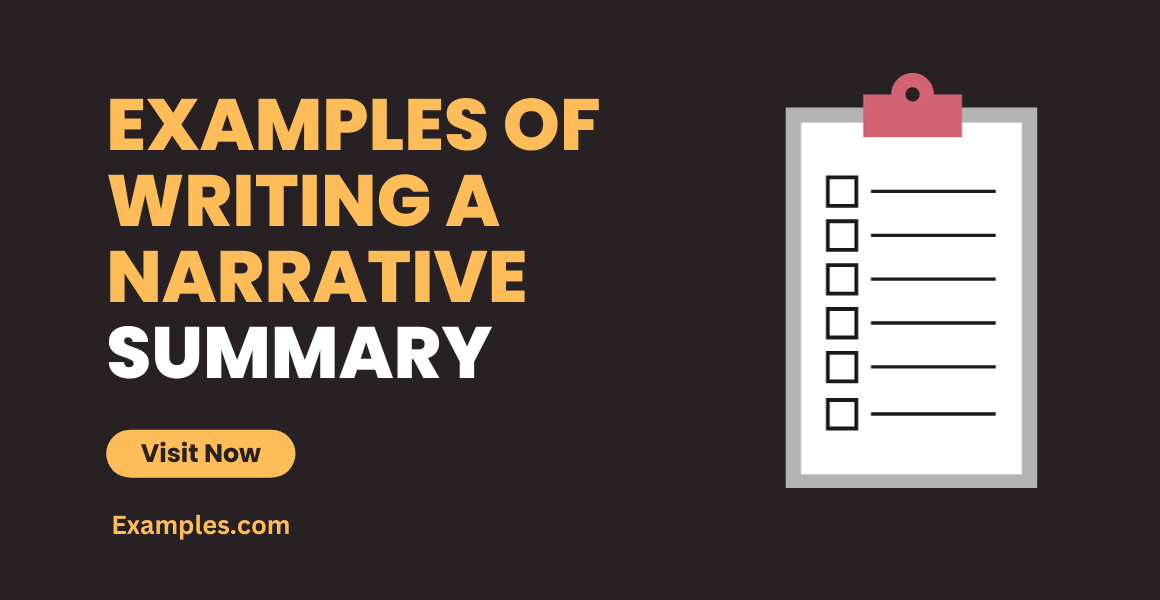Narrative Summary Examples
Being asked to do a narrative summary is not as uncommon as one thinks. Most of us have experienced doing this in high school or in elementary years. However, if you haven’t tried it, this task may take a lot of time do it but if you know what to do and with careful planning, you’ll ace your narrative summary.
Making a narrative summary is one way of storytelling and of course, narrative writing. Narrative allows a storyteller to tell tales of what has happened in the previous scenarios or add more context in the present terms. A narrative is also one way to transition from one scene to another through chronological events that were happening over time. A narrative summary can also be a descriptive summary; you are also describing the events, characters, and objects eloquently.

However, in a narrative summary, the essence of the dramatic highlights in the plot of the story are being summarized. It is less detailed in terms of visualization but the plot points are still present. It also helps readers, who are not able to read the full and detailed version of the story, will have knowledge of what is happening in the story.
The use of narrative summary has been in and out of fashion with the public. Stories, both oral and written, are a product for entertainment and are subjective to the tastes of their audience.
How to Write a Narrative Summary
To write a narrative essay, you’ll need to tell a story with lessons or insights to be learned by the audience. Telling a narrative summary in your part must be based in your own personal events; the interesting events or situations that happened to you or to anyone you know. Sometimes you may need to write a narrative summary based on a book or short story. Whatever it is that you’re writing, the format on how to write it are just the same.
Since it was mentioned earlier that narrative summaries also have the same elements of writing a descriptive summary; make your narrative more colorful and vivid to the readers; let them be in touch with their senses; make them feel like they could hear the sounds you are describing, picture out the images you’ve identified, and so on. Here are some ways on how to achieve it:
- Tell a story (if it’s based on your life) in a first-person point of view. Make it interesting. You can put your own writing style to make your story more engaging.
- Proceed to the action. Chuck out long intros and lengthy descriptions about a particular object, especially in the beginning of your narrative summary. You don’t need to describe the objects in a very detailed manner, you can use short and strong words to describe it.
- Your story should have a main theme; something that your readers can learn from the experience. If you’re writing a narrative summary based on a book or short story, don’t forget to include the lessons you’ve learned or the lessons implied in the book/short story.
Examples of writing vivid descriptive sentences:
- The city rain smells different from a countryside drizzle. The city rain reeks with the sewer scent.
- The mountain breeze is cold with the sweet pine scent while the sea breeze is warm that smells like salt.
- Tide pods look like it tastes like orange and peppermint flavored candy.
Take notes in writing your summary based on a book or short novel
Before you can write your summary, you need to collect all the important details you will put in your summary. Read the book first and take note of the name of each character along with their role in the story, a brief description of each individual scene in the story and its highlights, the type of conflict (e.g. man vs. man, man vs. nature, man vs. self, man vs. technology, man vs. fate, etc.) and the characters involved in this conflict, and the theme of the story and its lesson. This is your outline of what to include in your narrative summary. You can also do this outline if your summary is based on your own experiences.
Start with your introductory draft
Now that you have the information you need for your summary, it’s time to start your draft. First, focus on your introduction. Your opening lines must be direct and crisp. Make sure you state the title of the story as well as the name of the author (if the story is based on your experiences, put down your name.) Your introductory lines must be eye-catching. You could start with a rhetorical statement or question before you briefly describe the main characters and the supporting ones, the setting, the conflict, how it moves the plot, and the theme (the latter part may not be necessary to do as you can put it in the body or in the conclusion.)

Make the body
The body is where you will summarize each event of the story. Your notes that you’ve taken will be more useful in this part. You must follow the rule that each obstacle the main character faces should have its own paragraph. Focus how the main character resolves the conflict of the story.
Use concrete words
Effective narrative essays let their readers visualize the story in their minds. Another way for you to achieve this is to make use of concrete words rather than abstract words. Concrete words make your story and the images being conveyed clearer and more realistic to your readers. It can also make the story more grasping and emphatic. Abstract words are vague and generalized for you to convey an eloquent image.
Examples:
Abstract: I had a bad day.
Concrete: My coffee spilled on my white pants while I was in the office, I missed my taxi on my way home and had to wait for 30 minutes to get another one and my light exploded so I was left in the dark.
Abstract: Mark is intelligent but a slow thinker.
Concrete: Mark is an achiever in school; he’s always the top achiever in school, he’s advanced in math and has a wide vocabulary but it takes him a long time to grasp important matters in his personal life.
Abstract: Steffi is a beautiful girl.
Concrete: Steffi has brown flowing hair, deep aquamarine eyes with ivory skin and a Roman nose. Her smile is like the first day of spring and her voice is light like tinkling bells. Her beauty is way beyond compare.
Conclude with an insight
Now that you’re almost done with your draft summary, It’s time for the concluding part. This is where the conflicting events of the story will resolve. Explain how the characters developed throughout the course of the story. Relate your conclusion with the theme of your story. Making a memorable ending is one way to make your summary stand out. Now, in this case, you may want to put an insight/learnings/moral of the story. This way, your readers will remember the essence of your story. For example, you’re writing an insight from C.S. Lewis’ Chronicles of Narnia: The Silver Chair (the main theme of this story is perseverance in achieving your goal and facing your fears).

After the draft
Now that you’re finished writing your narrative summary draft, it’s now time to focus on the revision part. When revising, concentrate first on the structure of your summary; did you introduce the narrative clearly? Did you include and highlighted the major events in the body of your summary? Did you conclude the conflict with a good resolution? Did you put the moral learning of the story? Check if you did those. If you think it seems a bit lacking, then go address these parts. These are important parts of your narrative summary. Without these, your narrative summary may seem lacking. After you’ve taken care of this part, you can edit the grammar, spelling, vocabulary, and spelling of the words and names you put in the summary.
Now that you know how to write a narrative summary, you have the freedom on what will be your writing style. Make sure your narrative summary is something worth memorable, that people will inspire or get some good vibes from it. Happy writing!


